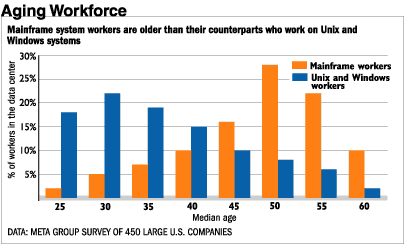
Half the mainframe talent has retired from Mission Linen Supply, Szerwo says.
Mainframe Talent: An Endangered Species
Big iron still gets big use, but lack of personnel is a growing problem
By Martin J. Garvey
InformationWeek
Mar. 4, 2002
It's estimated that 60% of corporate America's data sits in mainframes. IBM, the premier mainframe vendor, says its big iron business grew 15% last year. And for the first time in more than two decades, mainframe pricing went up. All of these are signs that mainframes are still vital IT systems.Nonetheless, General Mills Inc. is shutting down its Amdahl mainframe. The $13 billion maker of such foods as Cheerios, Betty Crocker cake mixes, and Yoplait yogurt is getting rid of the mainframe because it can't find replacements for its retiring mainframe experts, and it doesn't want to pay the high prices mainframe consultants command. So the Golden Valley, Minn., company is switching to Unix servers from Hewlett-Packard to support its inventory, order-entry, and customer-service applications. The transition should be completed by the end of next year.
Deciding to switch to Unix wasn't easy. There were concerns that Unix servers couldn't handle the big loads of the mainframe apps. "We heard horror stories about Unix scalability," says Mike Meinz, director of IT at General Mills. But Meinz says HP's new high-end Superdome, which began shipping in December, tackles the scalability concerns and, because it's Unix-based, General Mills won't be affected by the dwindling supply of mainframe expertise. And there's another benefit: Meinz says the HP platform should save General Mills a lot of administrative and management dollars by reducing the number of platforms the company has to support and by eliminating the need for outside mainframe consultants.
It's clear that there's a human-resources problem when it comes to the mainframe. According to studies done by Meta Group, 60% of the people in data centers housing mainframes are 50 or older; 10% are 60 or older. When comparing IT staffers who work on Unix and Windows servers with those who can work on mainframes, a striking age gap emerges: for example, 22% of Unix and Windows staffers are around the age of 30, compared with just 5% of mainframe workers who are around that age. Only 8% of Unix-and Windows-trained IT employees are 50 or older, according to the studies. Meta Group analyst Rob Schaefer says the mainframe isn't as sexy a system as Windows, Unix-based Web servers, or Linux. "For our mainframe customers, attrition is disproportionate compared to the other platforms," he says, "and no new blood is coming in."

Half the mainframe talent has retired from Mission Linen Supply,
Szerwo says.
However, not everyone will abandon mainframes in the foreseeable future. That's because of the huge investments companies have already made in mainframe applications and the millions of dollars it can take to migrate those applications to other platforms or host them at outsourcing shops.
There continue to be efforts designed to help businesses that are keeping their mainframes. For one, the mainframe is becoming more automated, so it requires fewer IT specialists to run and maintain it. Now, says Gartner industry analyst John Phelps, many companies are maintaining their mainframe environments, rather than developing new applications for them, and that typically requires about one-third the number of people. Some colleges are teaching mainframe skills and even getting funding from mainframe vendors such as IBM.
Also, tools are available to help ease integration between mainframe data, typically residing in DB2 and Cobol applications, and client-server and Web applications. Xbridge's Host Data Connect software, for example, can convert Cobol data into a Windows format.
The number of people with mainframe skills for such things as the MVS operating system, Cobol, and the Customer Information Control System started to erode during the '80s, says Ron Hankison, president and CEO of Xbridge. "By the end of that decade, only a few people knew what was going on with MVS, and eyes started to glaze over at the mention of Cobol, CICS, and the mainframe's transaction monitor," Hankison says. Still, he says there are 5 million to 9 million new lines of Cobol code written each year. "It's almost impossible to get rid of the mainframe," he says.
Candle Corp. is another vendor that offers tools designed to help companies integrate their mainframe applications with a Windows environment. It also offers the Omegamon XE performance-management tool, which provides real-time monitoring of system performance. The software includes a Java-based, Windowslike interface, which Candle says can reduce the learning curve and simplify day-to-day mainframe operations. For example, when a user of a customer-relationship management application that's pulling data from a mainframe experiences performance problems, the user can relay the problems directly to the mainframe administrators in a Windows format.

John Kogel, VP of the critical services management group at Candle, says his company may offer a service that compensates for customers' lack of resources. The service, which could be available in about six months, would include a Candle manager who works at the customer's site and interacts with 20 to 30 Candle employees at a central facility, each of whom is a specialist in Candle's mainframe products. The interaction is designed to produce specific results for the customer, and the service could help ease the mainframe pressures many companies feel, Kogel says. "There's a challenge get-ting people to handle the mainframe automation products," he says. "There's definitely pressure on the mainframe operational side of the house."
IBM also is trying to ease mainframe pressures, Gartner's Phelps says. It's providing grants to 40 universities and colleges, including Colorado State University, Marist College, and the University of Georgia, so they'll teach mainframe-oriented skills as part of their curriculum. It wouldn't disclose the value of the various grants. Not surprisingly, most of the IBM-funded education centers on Linux on the mainframe. IBM has ambitious plans under way to develop a Linux-only mainframe. The plans are to merge Linux with the hardware remote-access service functionality of the mainframe. Analysts say that a Linux mainframe lacks the heart of an IBM mainframe, the z/OS operating system, but it has the identical high-end hardware capabilities.
There are about 100 Linux applications from about 50 vendors available for the mainframe, including the Apache Web server, some E-mail apps, a firewall, and file-and-print applications, Gartner's Phelps says. Linux-based DB2 and Oracle applications also are being developed for the mainframe. The long-term life of the mainframe relies mostly on new applications. "Key to it all is the number of Linux apps running on the mainframe," he says. "People need to keep their eyes on it."
Some say grants won't be enough to sway college students who have their sights set on Web applications. And most schools don't offer much in the way of mainframe education. The decreasing number of mainframe experts will likely be costly to companies that need them. Companies can find people with mainframe skills, but it can cost them a lot, says Mark Hudson, HP's worldwide marketing manager for Unix. "You're not replenishing the supply," he says. "That's going to drive up the costs."
IT managers agree that the talent supply is decreasing and there doesn't appear to be a new breed of workers to step in and fill the gaps. "They don't train them in school," insists Dan Newkirk, systems consultant at Farmers Insurance Group in Los Angeles. "In general, there's a limited supply of people with [these] skill sets."
Farmers needs mainframe experts: It has 6,000 mainframe Mips on the data-center floor. That enormous amount of processing power is split among an IBM mainframe and PCMs (plug-compatible machines) from Amdahl and Hitachi Data Systems. For now, Farmers' staff--most of whom are in their 40s--are well-equipped to manage the mainframes, Newkirk says. In addition, the company uses consultants and some offshore programmers for application development.
While such offshore programming is fine for application development, Newkirk says the insurer still needs people on site to handle upgrades, replace old or damaged components, and start the mainframe's automated processes using Candle's Omegamon XE/DE tools. "Farmers tries to bring outside talent in, but the pool is limited," he says. Still, the insurer will have to find a way to continue supporting its mainframes. "There's no end in sight to the mainframes," Newkirk says. "There's a huge investment poured into that development."
Companies such as Farmers hope that ongoing mainframe developments such as automation, integration tools, and even a renewed effort to train up-and-coming IT workers in the art of mainframes will ensure that their investments are safe.
Newkirk says Farmers has plenty of staffers willing to train potential new hires who are just coming out of college or who lack the necessary mainframe skills. Farmers' mainframe expertise should remain relatively stable for at least a decade, until those workers are trained, he says. Of course, the mainframe specialists there will continue to get help from the offshore programmers, outside consultants, and all-important automation software that helps reduce the IT department's mainframe workload. All of this should keep Farmers' 6,000 (and growing) Mips humming--at least for a while.
Copyright 2002